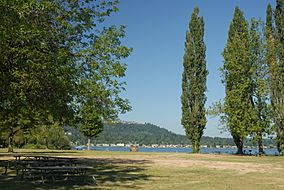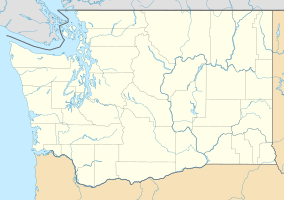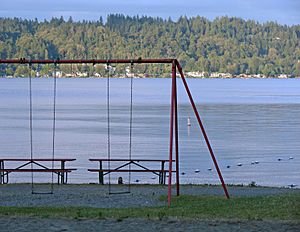Lake Sammamish State Park facts for kids
Quick facts for kids Lake Sammamish State Park |
|
|---|---|

The state park viewed from the southeast end of Lake Sammamish in 2006
|
|
| Location | Issaquah, Washington, U.S. |
| Area | 512 acres (207 ha) |
| Elevation | 36 ft (11 m) |
| Established | 1950 |
| Operator | Washington State Parks and Recreation Commission |
| Website | Lake Sammamish State Park |
Lake Sammamish State Park is a fun place to visit in King County, Washington, USA. It's located at the very south end of Lake Sammamish. This park is managed by the Washington State Park System.
The park is quite large, covering about 512 acres (which is like 388 football fields!). It also has over a mile of beautiful waterfront along the lake. Issaquah Creek flows right into Lake Sammamish inside the park. It's a super popular spot for boating and other water sports, like waterskiing.
Getting to the park is easy! You can take Interstate 90 to exit 15. There are about 250 parking spots for cars and trailers. If you prefer public transport, several bus routes (200, 216, 217, and 927) can take you there.
Contents
Fun Things to Do at Lake Sammamish State Park
Lake Sammamish State Park has lots of cool things to do during the day! The park is split into three main areas, each with different activities.
West Side Activities
The area west of Issaquah Creek is packed with fun. You'll find many picnic tables and shelters, perfect for a family lunch. There are also two swimming beaches, called Tibbetts Beach and Sunset Beach, where you can cool off. Restrooms are available, along with fields for sports.
Sports Fields
If you love sports, this is the place! The park has two softball fields. It also has seven full-size soccer fields and four smaller soccer fields for younger players. There are separate parking areas for each group of soccer fields. You can get to this part of the park from NW Sammamish Road.
East Side Adventures
East of Issaquah Creek, you'll find a boat launch. This is where people can put their boats into Lake Sammamish. There are also trails for walking and exploring nature. This area is home to lots of natural plants and animals.
Hans Jensen Youth Camp
Even further east, past East Lake Sammamish Parkway, is the Hans Jensen Youth Camp. This camp offers special programs for young people. You can enter these eastern areas from East Lake Sammamish Parkway SE.
Keeping You Safe at the Park
Lake Sammamish State Park is a safe place for everyone to enjoy. Park Rangers are always on patrol. They are like police officers for the park and help make sure everyone follows the rules. Local police officers also help keep the park safe. If there's an emergency, Eastside Fire and Rescue is ready to help with medical needs or fires.
Park History and Nature
The land where Lake Sammamish State Park and the city of Issaquah now stand has a very long history. Native American tribes lived here for many, many years.
Early Native American Life
The Snoqualmie, Sammamish, and Duwamish tribes lived in this area. They fished in the lake and creeks, hunted, and gathered plants like camas. The area was once covered in tall, old-growth forests mixed with open prairies. These forests stretched all the way to the lake's edge.
Changes Over Time
In the 1860s, new settlers started arriving. They began to cut down the huge cedar and fir trees from the park area. These trees were floated down the lake to sawmills. Later, farms for hops and dairy cows took over the cleared land. Miners also came to the area, making Issaquah known for its coal mines. All this activity changed the landscape a lot.
Forests Grow Back Differently
After the big trees were cut down, new forests grew back. But these new forests were different. They had more deciduous trees, like cottonwoods and big leaf maples, instead of the original tall evergreen trees. This happened because new trees were not planted on purpose.
Native Plants and Animals
The native tribes used to manage the drier prairie areas by burning them sometimes. This helped certain plants like Garry oaks and camas grow. They also gathered many other plants for food and medicine, such as salmonberry, huckleberry, and wild ginger. Many of these plants are not as common in the park today.
Water Changes and Sedimentation
When the forests were removed, more water ran off the land into the lake. The thick forest floor used to soak up a lot of water. This increased runoff, along with farming and mining, caused a lot of sedimentation (dirt and sand) to flow into the lake.
Lake Level Changes
This extra sediment, plus development along the shoreline, has actually made the lake level a bit higher than it used to be. The bottom of Issaquah Creek is also higher now because of all the sediment. This means some areas that were once dry forests are now wet and muddy for much of the year. Efforts to fix this have been made, but more funding is needed.



